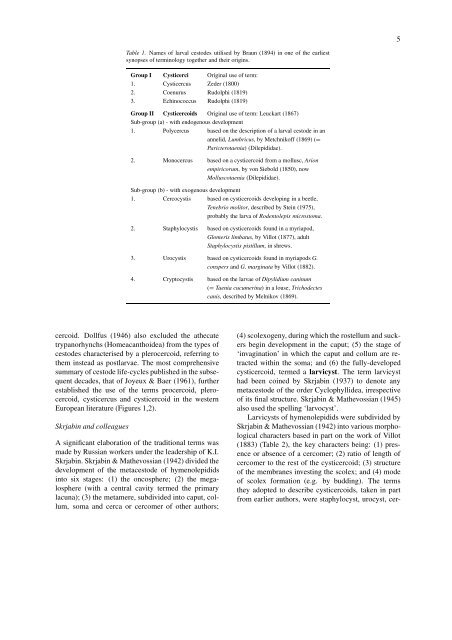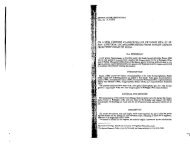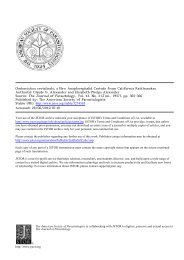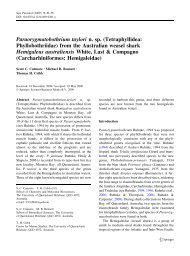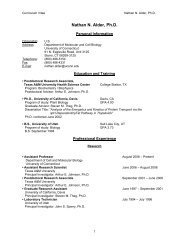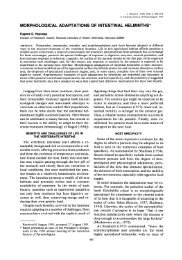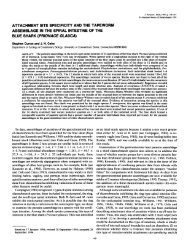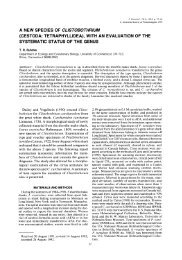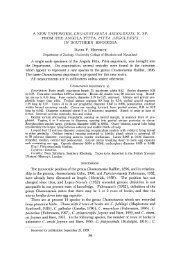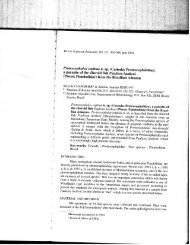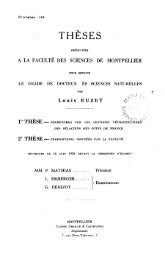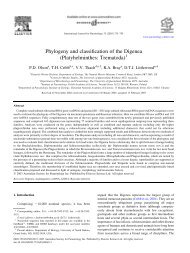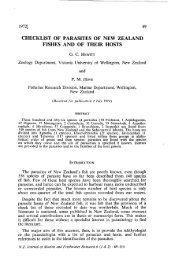The terminology of larval cestodes or metacestodes
The terminology of larval cestodes or metacestodes
The terminology of larval cestodes or metacestodes
Create successful ePaper yourself
Turn your PDF publications into a flip-book with our unique Google optimized e-Paper software.
5Table 1. Names <strong>of</strong> <strong>larval</strong> <strong>cestodes</strong> utilised by Braun (1894) in one <strong>of</strong> the earliestsynopses <strong>of</strong> <strong>terminology</strong> together and their <strong>or</strong>igins.Group I Cysticerci Original use <strong>of</strong> term:1. Cysticercus Zeder (1800)2. Coenurus Rudolphi (1819)3. Echinococcus Rudolphi (1819)Group II Cysticercoids Original use <strong>of</strong> term: Leuckart (1867)Sub-group (a) - with endogenous development1. Polycercus based on the description <strong>of</strong> a <strong>larval</strong> cestode in anannelid, Lumbricus, by Metchnik<strong>of</strong>f (1869) (=Paricterotaenia) (Dilepididae).2. Monocercus based on a cysticercoid from a mollusc, Arionempiric<strong>or</strong>um, by von Siebold (1850), nowMolluscotaenia (Dilepididae).Sub-group (b) - with exogenous development1. Cercocystis based on cysticercoids developing in a beetle,Tenebrio molit<strong>or</strong>, described by Stein (1975),probably the larva <strong>of</strong> Rodentolepis microstoma.2. Staphylocystis based on cysticercoids found in a myriapod,Glomeris limbatus, by Villot (1877), adultStaphylocystis pistillum, in shrews.3. Urocystis based on cysticercoids found in myriapods G.conspers and G. marginata by Villot (1882).4. Cryptocystis based on the larvae <strong>of</strong> Dipylidium caninum(= Taenia cucumerina) in a louse, Trichodectescanis, described by Melnikov (1869).cercoid. Dollfus (1946) also excluded the athecatetrypan<strong>or</strong>hynchs (Homeacanthoidea) from the types <strong>of</strong><strong>cestodes</strong> characterised by a plerocercoid, referring tothem instead as postlarvae. <strong>The</strong> most comprehensivesummary <strong>of</strong> cestode life-cycles published in the subsequentdecades, that <strong>of</strong> Joyeux & Baer (1961), furtherestablished the use <strong>of</strong> the terms procercoid, plerocercoid,cysticercus and cysticercoid in the westernEuropean literature (Figures 1,2).Skrjabin and colleaguesA significant elab<strong>or</strong>ation <strong>of</strong> the traditional terms wasmade by Russian w<strong>or</strong>kers under the leadership <strong>of</strong> K.I.Skrjabin. Skrjabin & Mathevossian (1942) divided thedevelopment <strong>of</strong> the metacestode <strong>of</strong> hymenolepididsinto six stages: (1) the oncosphere; (2) the megalosphere(with a central cavity termed the primarylacuna); (3) the metamere, subdivided into caput, collum,soma and cerca <strong>or</strong> cercomer <strong>of</strong> other auth<strong>or</strong>s;(4) scolexogeny, during which the rostellum and suckersbegin development in the caput; (5) the stage <strong>of</strong>‘invagination’ in which the caput and collum are retractedwithin the soma; and (6) the fully-developedcysticercoid, termed a larvicyst. <strong>The</strong> term larvicysthad been coined by Skrjabin (1937) to denote anymetacestode <strong>of</strong> the <strong>or</strong>der Cyclophyllidea, irrespective<strong>of</strong> its final structure. Skrjabin & Mathevossian (1945)also used the spelling ‘larvocyst’.Larvicysts <strong>of</strong> hymenolepidids were subdivided bySkrjabin & Mathevossian (1942) into various m<strong>or</strong>phologicalcharacters based in part on the w<strong>or</strong>k <strong>of</strong> Villot(1883) (Table 2), the key characters being: (1) presence<strong>or</strong> absence <strong>of</strong> a cercomer; (2) ratio <strong>of</strong> length <strong>of</strong>cercomer to the rest <strong>of</strong> the cysticercoid; (3) structure<strong>of</strong> the membranes investing the scolex; and (4) mode<strong>of</strong> scolex f<strong>or</strong>mation (e.g. by budding). <strong>The</strong> termsthey adopted to describe cysticercoids, taken in partfrom earlier auth<strong>or</strong>s, were staphylocyst, urocyst, cer-


